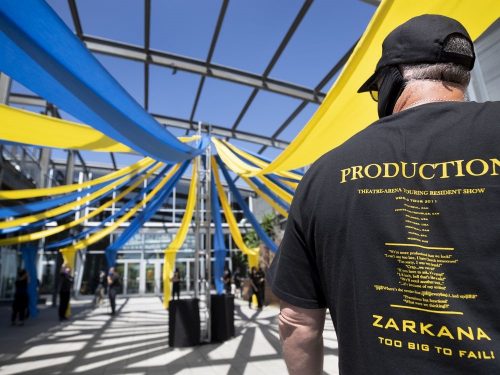Tuesday was the 36th anniversary of the first Cirque du Soleil show, and a group of circus performers and artisans marked the birthday by erecting a blue-and-gold big top at the Old Port, not far from where the Cirque normally puts up its own, much larger big top.
These Cirque artists were there to underline the notable day in the company’s history, and to remind people that the troubled Montreal-based circus, which is in dire financial straits, owes them $1.5 million for work they have done over the past year.
Also at the protest was Gilles Ste-Croix, who co-founded the Cirque with Guy Laliberté in the first half of the ’80s. The two were part of a ragtag group of street performers in Baie-St-Paul that morphed into what would become the world’s leading circus, and one of the planet’s biggest live-entertainment companies.
Ste-Croix says he backs the artists and feels strongly that the Cirque has lost its way in the five years since Laliberté sold the company for a reported US$1.5 billion to American and Chinese investors.
“It’s a sad thing, because I always say that the Cirque du Soleil is the energy of the creators and workers who … bring it together,” said Ste-Croix. “The Cirque du Soleil is not a big top — it’s a show, and a show is human energy and human creativity. I think it’s sad that they stopped paying them. And it was not a question of COVID — it was a question of bad finance. They ran out of money before COVID.”
Since it was bought by a consortium led by U.S. private equity firm TPG Capital in 2015, the Cirque has spent US$550 million to grow the company. Even before the pandemic forced the Cirque to close all its shows, there were warning clouds on the horizon. The Cirque had shuttered its latest Las Vegas show, R.U.N., a box-office bomb that cost the company US$60 million. It was also saddled with US$1 billion in debt. When the global box office went dry in March, the Cirque had to lay off just under 4,700 employees — 95 per cent of its staff.
“Already last year we could see that there were some problems,” said Ste-Croix. “They were putting out many, many shows, and a couple of them didn’t work out. … It was a question of how they were going about the development. Having so many shows out on the road … demands lots of money to finance, hoping to make a buck out of it. But it didn’t work out that way, and they were, I’d say, stretching to finance all this debt — and finally COVID came and it stopped all the revenue. So of course (the company) was in bad shape … but already in January they stopped paying these people here. That’s way before the middle of March,” when COVID hit hard in North America.
The problems started when the Cirque was sold in 2015, said Ste-Croix.
“If you buy Cirque du Soleil at such a high price … you want a return on your money,” he said. “But the recipe to make money — and we did for 30 years — was create good shows and sell them! Develop markets. Of course that costs money. But you don’t cut on creativity. That’s what the Cirque du Soleil trademark is. The last few shows they put out, (there) was not so much money in the creativity.”
Laliberté recently announced he intends to make a bid to buy back the Cirque, and Ste-Croix said he supports his old pal’s plan.
The Quebec government has given the Cirque a US$200-million loan. Gabriel Dubé-Dupuis, who organized the protest Tuesday, said he would like Cirque executives to guarantee that any sales agreement will include a clause promising that the artisans will be paid.
{ SOURCE: Brendan Kelly, Montreal Gazette }
